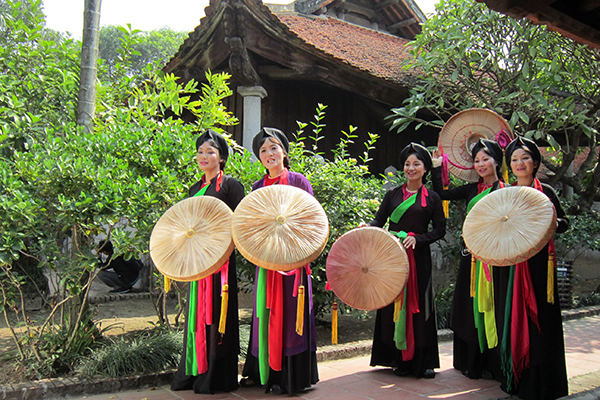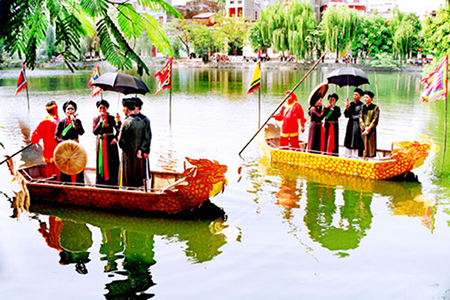After crossing the Chuong Duong bridge which was built parallel to the Doumer (Long Bien) bridge twenty years ago, we enter the territory of Kinh Bac, the famous native region of the Ly royal dynasty (11th -13th centuries) which abounds in historical vestiges. Twenty kilometers northeast of Hanoi, rolling hills dot the green rice fields of the Red River delta.
Lim village, known all over the country for the quan ho songs that groups of young men and women toss back and forth, lies along- side the macadamized road. My American friend Dan Duffy and I have been invited to attend the rite of wood-cutting (le phat moc) which inaugurates the rebuilding of the communal house burnt down by French troops in 1947 at the start of the First Indochina War. We climb to the top of a hill to see Lim pagoda which has been partly restored.
Turned into a military post in 1950 by French troops, it was destroyed by them when they had to withdraw. The courtyard is now littered with wooden Buddha statues being cut by Ha Tay craftsmen. We also visit other temples within a 8 – 10 kilometer radius which were likewise damaged in the same war: the Phat Tich (Buddha’s Traces) pagoda where only a stone statue of Amitabha remains together with broken parts of heretic stone animals, ancient stupas, and the recently discovered mummy of a monk; the Tram Gian (One-Hundred-Bayed) pagoda, restored but barely recognizable; the Temple of the Eight Kings of the Ly Dynasty (Ly Bat De), whose restored parts are rather impressive. This year, a delegation of about fifty Korean descendants of a Ly prince made a pilgrimage to the sanctuary.

Let’s go back to Lim, the cradle since time immemorial of quan ho folksongs sung by farmers of about fifty prosperous villages in an area of sixty square kilometers. The quan ho are sung on various occasions: spring festivals, weddings, friendly meetings…
Each year, on the 13th day of the first moon, a festival is held by the local people on the slopes of a hill. But they also sing in the fields, on the edge of the woods, the road or the pond, on rowboats… Groups of a dozen young men or women go about in the open. They are dressed in their best clothes; men carry with them an umbrella of black silk, women a fan under a cartwheel palm-leaf hat tucked under their arms. A female group may be the first to go up to a male group and offer it betel quids, thus striking up an acquaintance. A dialogue begins in the form of songs. It may be a male group which takes the initiative. In any event, courtliness is the rule. The men call themselves “Your younger brothers” and address the women as “Our elder sisters”; conversely, the women call themselves “Your younger sisters” and address the men as “Our elder brothers”. Female duets keep up the conversation by exchanging songs with male duets.
Conversational sets of words are used to show modesty. For instance, if the female group is invited to sing first, it will say: “How dare we! You elder brothers are like the moon that shines in the sky, we your younger sisters are but tiny lamps lighting small cottages.” The men will answer unpretentiously: “Please be the first to sing, elder sisters, we’ll follow suit”. A song sung on a certain tune must be answered on the same tune, the repertory comprising hundreds of tunes. All errors will be gently corrected. One can sing known songs or create new ones on known tunes. There is no accompanying instrumental music. The voice is enough to sing the joy of life, the love of the land, or to say sweet nothings which could exude merriment, nostalgia, or amusement, like this very popular song:
“To the beloved one, one gives one’s shirt
Back home, one will lie to father and mother:
As I cross the bridge, the wind has blown it away.”
In the course of that exchange of songs, if two groups (one male, one female) from two different villages like each other’s voices, manners, etc., they promise to meet again. On the set day, the male group goes to the home of the head of the female group (who is given the courteous title of Second Sister, her friends being called Third, Fourth… Sisters; the same appellations are given the male group; Second, Third, Fourth… Brothers). The two groups are seated facing each other on two long benches or in two aisles. The lyrical exchange of songs will last a whole night, with only a break for a light meal. The final phase is reserved for farewell songs, with such moving words as: “Do stay on, friends, don’t go vet!”, and “Don’t miss our next rendezvous!”…
One thing that Westerners may fail to understand: the two groups thus twinned are linked together by fraternal or artistic affection rather than love; their members must not get married. A woman may be a man’s intimate friend but not his mistress; they may give each other gifts: a ring, a scaft, a comb… If after his marriage (to another woman) the man should pay a visit to his friend (married to another man), the woman’s husband will discreetly stay away so as not to be cause for embarrassment. And, as custom would have it, children of the two couples will often strike up close friendships.
The customs and usage prevalent in quan ho villages seem rather unusual in a country where Confucian traditions forbade all contact between boys and girls even when they were, quite young. Yet they are not confined to Lim. In many villages of North Vietnam, songs are tossed back and forth between groups of young men and women at the time of the autumn harvest. This custom probably originates in the cult of fecundity. In a certain way, it may be compared to the equinoctial festivities observed in ancient China, studied by Marcel Granet: “The most salient rite is a joust of dancing and singing, a rhythmic tournament leading to the birth of love between people predestined to be spouses by traditional rules”.

